Afghanistan is home to a wide variety of bird species, ranging from large raptors to small passerines. The country is located in a unique geographical location, providing an ideal habitat for many species of birds.
Afghanistan is a landlocked country that shares borders with many other countries, including Iran, Pakistan, and Turkmenistan, all of which are home to a diverse range of bird species.
This rich avian diversity is further enhanced by the country’s mountainous terrain and diverse climates, providing a perfect habitat for a wide range of species.
In this article, we will explore the different species of birds found in Afghanistan and discuss the importance of their preservation.
1. Bar-Tailed Treecreeper
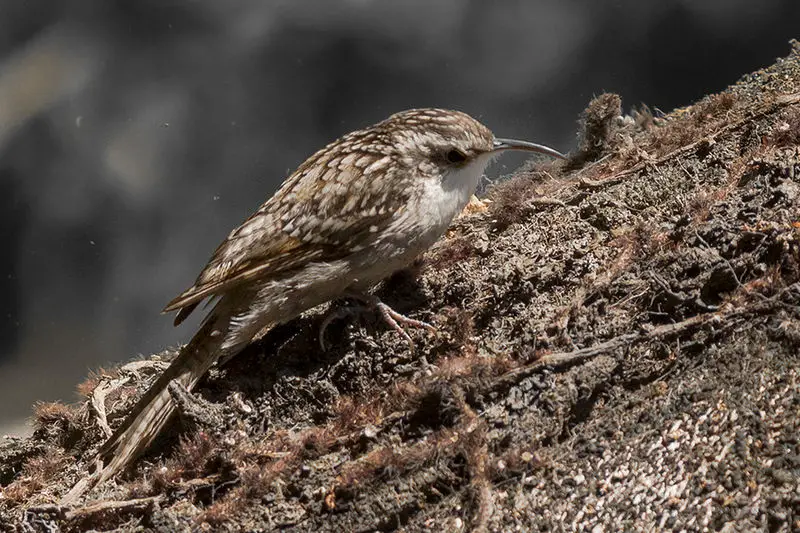
The Bar-tailed Treecreeper is a species of bird found in the northern parts of the Indian subcontinent, including Afghanistan, India, Iran and Nepal.
It has adapted to live mainly in coniferous forests and rocky hillsides at an altitude range from 1000m – 4500m.
Its plumage is generally greyish brown above with white underparts and rufous wings; it also bears a small bill which helps them seek out insects hidden deep within tree bark or cracks.
They are agile climbers who creep up trunks searching for food such as ants and other tiny invertebrates using their long curved claws.
The Himalayan Treecreeper can often be seen clambering around trees during its active hours between dawn till dusk making loud calls that sound like “chick chick”.Scientific classification:
| Kingdom | Animalia |
| Phylum | Chordata |
| Class | Aves |
| Order | Passeriformes |
| Family | Certhiidae |
| Genus | Certhia |
| Species | C. himalayana |
2. Black-Headed Jay
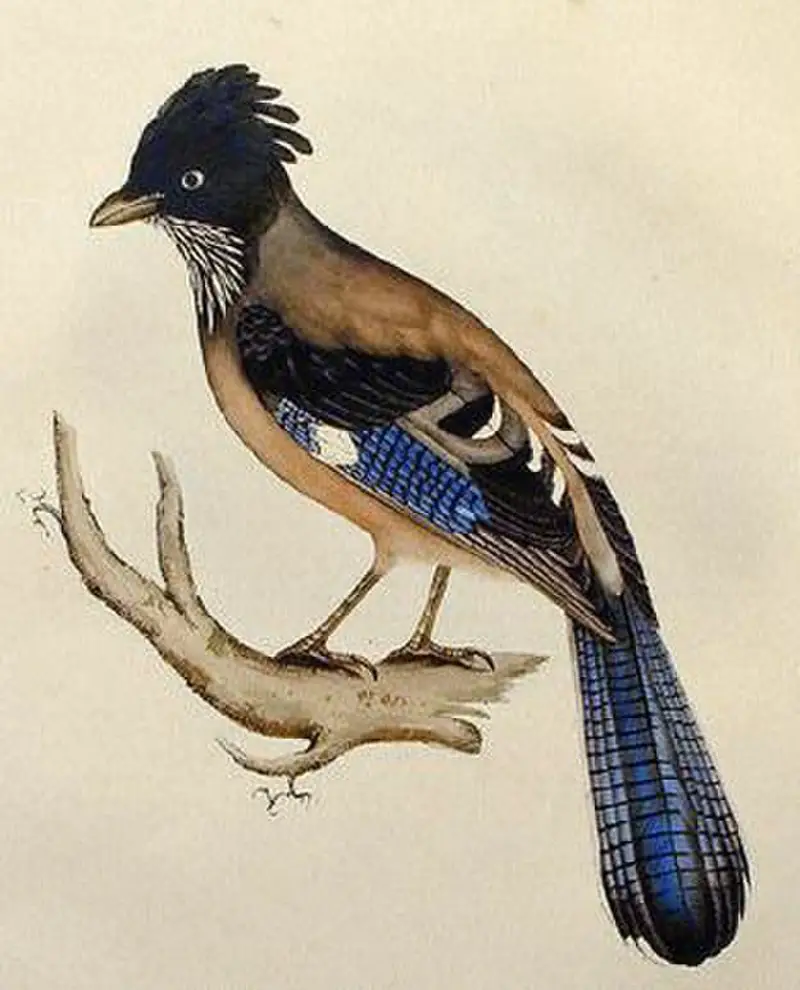
The Black-headed Jay is a stunning bird with its black head and crest, contrasting against the brown feathers of its body. It has long tail feathers that give it an elongated appearance.
This species can be found in Eastern Afghanistan, across the Himalayas to India, Nepal and Bhutan. They are roughly similar size as Eurasian jays but have slightly shorter and thicker bills.
These birds forage on ground level for insects or seeds which they store in their crop before taking them back to their roosts where they feed others from their stash – this behaviour makes them quite popular among farmers.
In addition they also eat fruits such as berries when available during winter months providing food sources for other animals too due to regurgitation of undigested remains.Scientific classification:
| Kingdom | Animalia |
| Phylum | Chordata |
| Class | Aves |
| Order | Passeriformes |
| Family | Corvidae |
| Genus | Garrulus |
| Species | G. lanceolatus |
Also Featured In: Birds that Live in Uttarakhand, Birds of Islamabad
3. Afghan Snowfinch
The Afghan snowfinch is a small passerine bird belonging to the sparrow family, native to northern parts of the Hindu Kush mountains in Afghanistan. It has brown-grey upperparts, white underparts and a black band across its breast.
It also features two buff wing bars with distinct dark streaks on them. Its diet consists mainly of seeds from grasses and herbs found around rocky areas at high altitudes where it makes its home.
Despite having such a restricted range, there are no major threats faced by this species so it is classified as Least Concern on the IUCN Red List.Scientific classification:
| Kingdom | Animalia |
| Phylum | Chordata |
| Class | Aves |
| Order | Passeriformes |
| Family | Passeridae |
| Genus | Pyrgilauda |
| Species | P. theresae |
4. Streaked Scrub Warbler
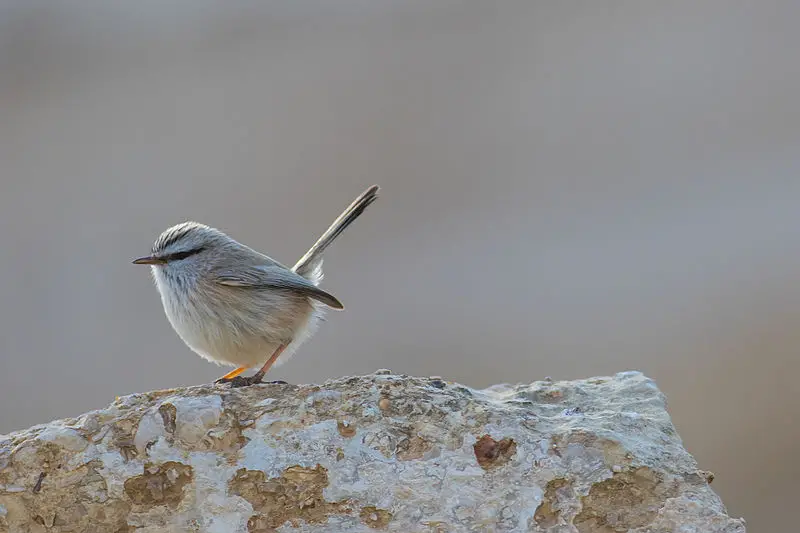
The Streaked Scrub Warbler is a small passerine bird, found in northern Africa and southwestern Asia.
It frequents scrubby areas, ravines and gorges near deserts, remaining mainly resident but with possible local movements outside the breeding season.
This species has grayish-brown upperparts streaked with black lines or bars forming an intricate pattern across its back; whitish underparts are also marked by dark streaks on the breast.
Its diet consists of insects which it catches from low vegetation while making short flights over them to capture prey as well as gleaned items from branches or foliage surface foraged on foot.
The Streak Scrub Warbler is quite vocal throughout the year giving various trills and whistles that sound like “seet”.Scientific classification:
| Kingdom | Animalia |
| Phylum | Chordata |
| Class | Aves |
| Order | Passeriformes |
| Family | Scotocercidae Fregin, Haase, Olsson, & Alström, 2012 |
| Genus | Scotocerca Sundevall, 1872 |
| Species | S. inquieta |
Also Featured In: Common Algerian Birds , Birds That Live in Iraq
5. See-See Partridge
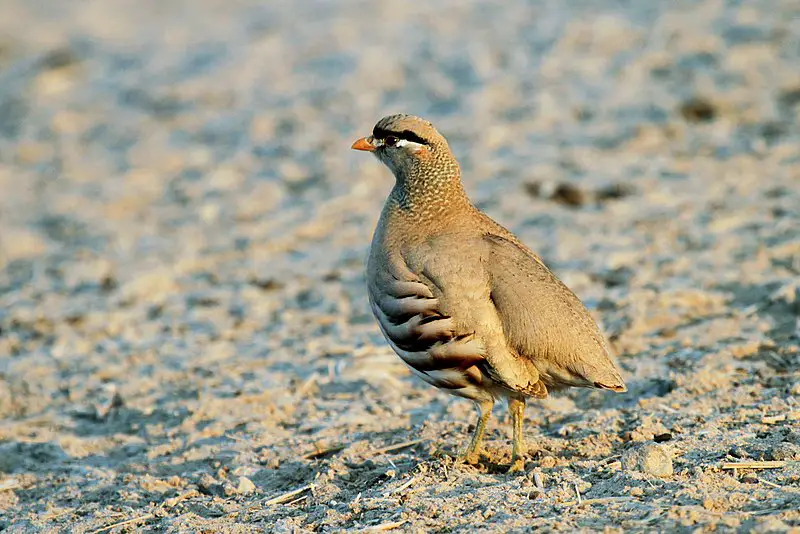
The See-see Partridge is a gamebird belonging to the pheasant family. It can be found across southeast Turkey, Syria, Iraq, Iran and Pakistan.
This bird measures around 22–25 cm in length and has greyish plumage with a dark chestnut coloured throat patch.
Its closest relative is the Sand Partridge which can be found in Egypt and Arabia.
The See-see partridge lives mainly on open ground where it feeds on insects while scratching for seeds or other plant material amongst the vegetation cover.
It makes its nest among rocks or low bushes laying up to 10 eggs at once which are incubated by both parents who also care for their young until they fledge about 4 weeks later.
Despite being hunted as food source this species remains relatively common across its range but threats from habitat destruction could put them under threat in future years.Scientific classification:
| Kingdom | Animalia |
| Phylum | Chordata |
| Class | Aves |
| Order | Galliformes |
| Family | Phasianidae |
| Genus | Ammoperdix |
| Species | A. griseogularis |
Also Featured In: Common Uzbekistan Birds,
6. White-Cheeked Bushtit
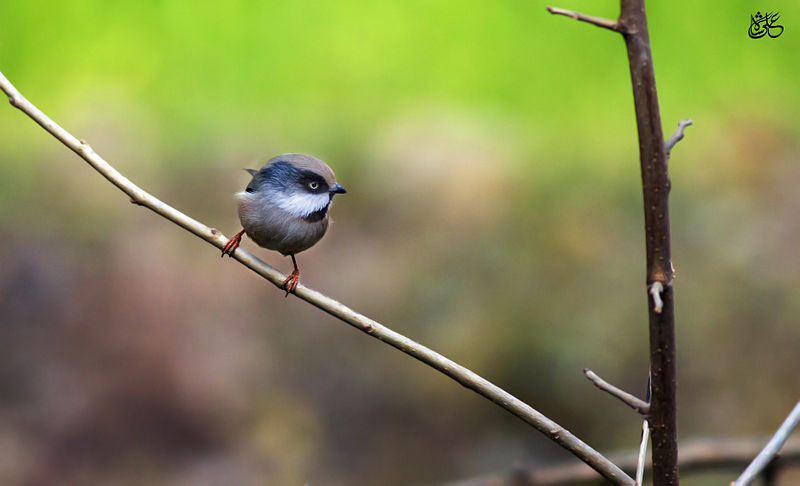
The White-cheeked Bushtit is a small and distinctive bird found primarily in Afghanistan, India, and Pakistan. This species has greyish upperparts with an off-white underside that gives it its characteristic name.
The face of the White-cheeked Bushtit is also white while wings are black with two narrow whitish bars on each side. They have short tails which they use to balance when perching or flying from tree to tree.
These birds feed mainly on insects but will occasionally consume berries as well as other fruits and seeds.
During breeding season, males sing loudly to attract mates; their song can be heard over long distances due to the clarity of sound production by this species’s vocal cords.
In addition, these birds are highly social creatures often seen travelling together in flocks for protection against predators such as hawks or falcons.
All things considered, the White-cheeked Bushtit is a fascinating bird worthy of admiration.Scientific classification:
| Kingdom | Animalia |
| Phylum | Chordata |
| Class | Aves |
| Order | Passeriformes |
| Family | Aegithalidae |
| Genus | Aegithalos |
| Species | A. leucogenys |
7. Himalayan Prinia
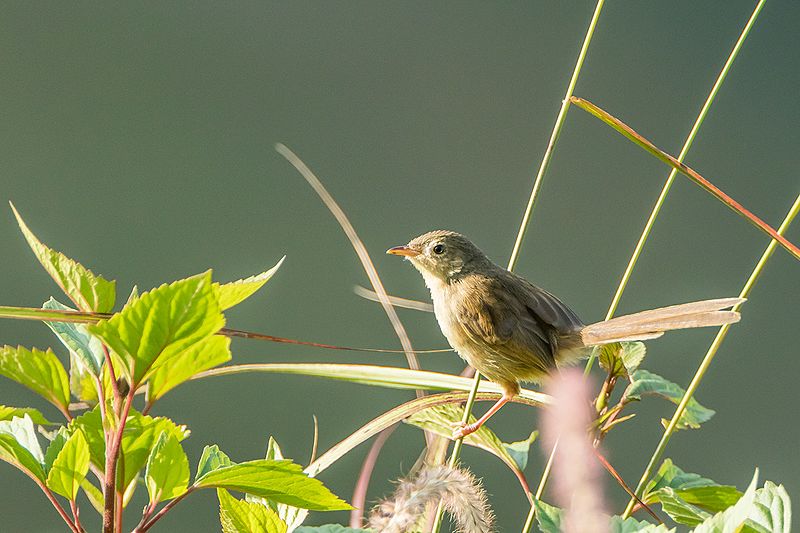
The Himalayan prinia is a small, vocal bird belonging to the family Cisticolidae. It has a distinctive striped pattern on its back and wings that sets it apart from other birds in the same family.
This species of bird is found mainly in India, Pakistan, Afghanistan, Bhutan Nepal and Yunnan province of China along the Himalayas mountain range.
They have adapted to living among humans as they are often seen near villages or agricultural fields due their preference for open habitats with shrubs and trees nearby.
The diet consists mainly of insects but some fruits may be eaten during winter months when food sources become scarce. As one of nature’s most remarkable singers, these songbirds provide us with delightful background music much appreciated by those who love nature sounds.Scientific classification:
| Kingdom | Animalia |
| Phylum | Chordata |
| Class | Aves |
| Order | Passeriformes |
| Family | Cisticolidae |
| Genus | Prinia |
| Species | P. crinigera |
8. Himalayan White-Browed Rosefinch
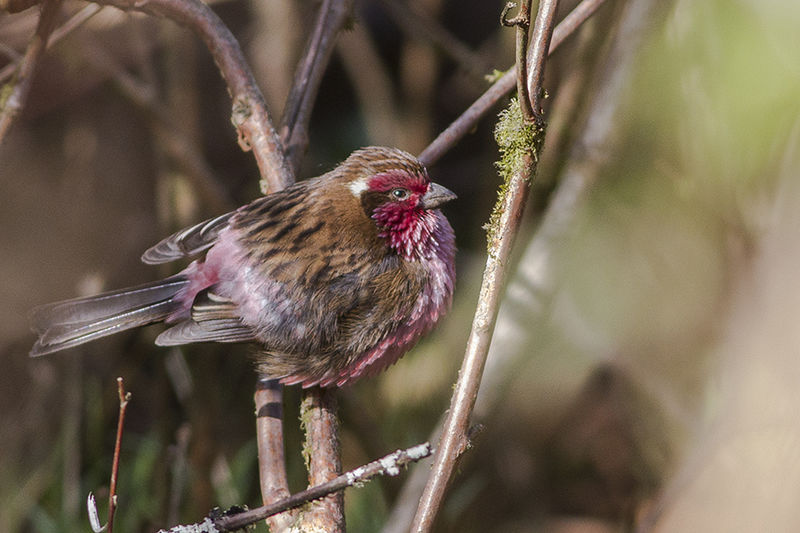
The Himalayan white-browed rosefinch is a beautiful finch species native to the Himalayas. It has an impressive range, ranging from Afghanistan in the west all the way eastwards into India, Tibet, Bhutan and Nepal.
In its natural habitats it prefers temperate forests or shrubland areas where plenty of food can be found.
Its plumage varies depending on region but usually consists of shades of browns with black patches and grey wings – hence its common name ‘white-browed’.
With a short bill they feed mainly on grasses such as seeds and grains which are abundant in their environment.
They also take advantage of flowers that bloom during certain seasons for added nutrition throughout the year.Scientific classification:
| Kingdom | Animalia |
| Phylum | Chordata |
| Class | Aves |
| Order | Passeriformes |
| Family | Fringillidae |
| Subfamily | Carduelinae |
| Genus | Carpodacus |
| Species | C. thura |
9. Bay-Backed Shrike
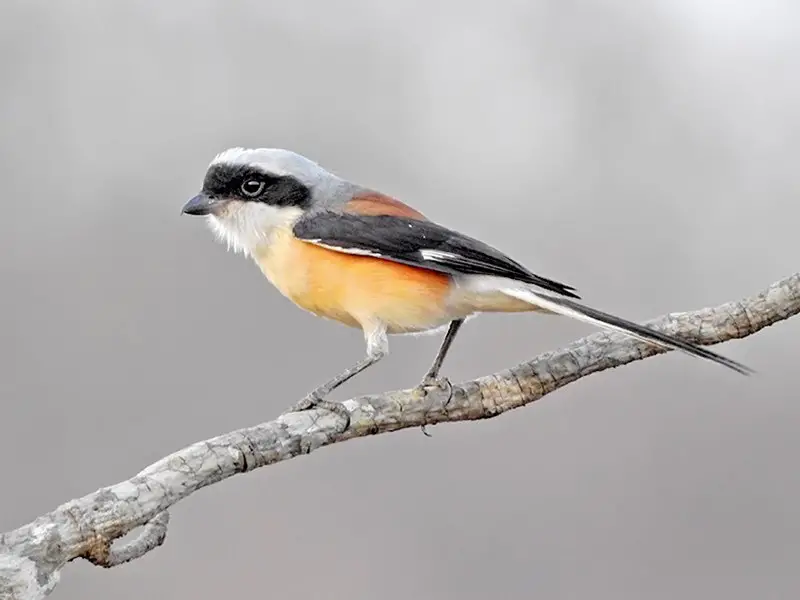
The Bay-backed Shrike is a small, but striking bird native to South Asia. It measures just 17 cm long and has maroon-brown upperparts with a pale rump and a long black tail edged in white.
The underparts are white, while the crown and nape of its neck are grey with a distinctive “bandit mask” of black through the eye area.
Additionally, it has an easily visible white wing patch that contrasts nicely against its otherwise dark plumage.
This species makes for an interesting sight as they search open woodlands or scrubland for their prey including insects, reptiles, amphibians and rodents which they impale on thorns or barbed wire fences like other shrikes.Scientific classification:
| Kingdom | Animalia |
| Phylum | Chordata |
| Class | Aves |
| Order | Passeriformes |
| Family | Laniidae |
| Genus | Lanius |
| Species | L. vittatus |
10. Blue-Capped Redstart
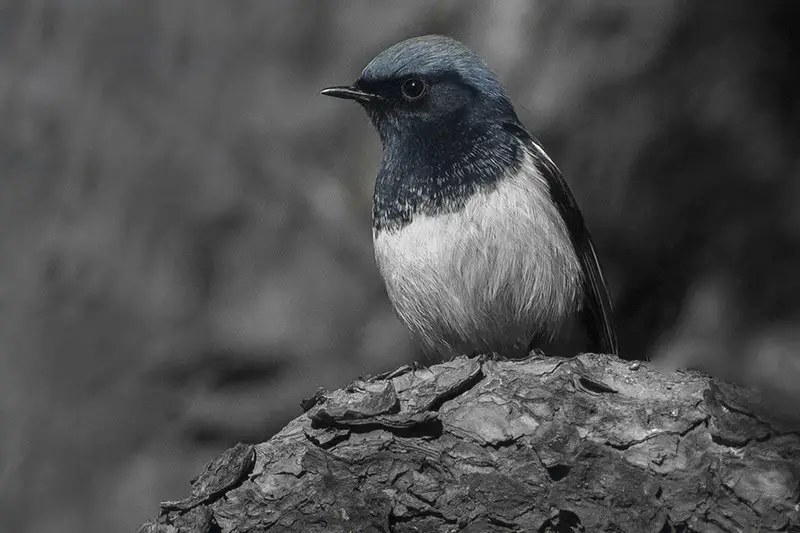
The Blue-capped redstart is a striking bird found throughout the Himalayas and northern parts of India. This beautiful species has an unmistakable blue cap, grey back, white throat and black wings with bright orange patches on them.
It can often be seen flitting around in open areas such as fields or scrubland, while its song consists of loud trills and rattles.
The diet mainly consists of insects which it catches by flying after them from a perch before returning to the same spot afterwards.
They are monogamous birds who form strong pairs during breeding season when they build cup shaped nests made out of grasses near streams or ponds for their young ones to hatch in safety. A truly remarkable sight that deserves respect.Scientific classification:
| Kingdom | Animalia |
| Phylum | Chordata |
| Class | Aves |
| Order | Passeriformes |
| Family | Muscicapidae |
| Genus | Phoenicurus |
| Species | P. coeruleocephala |
11. Brown Accentor
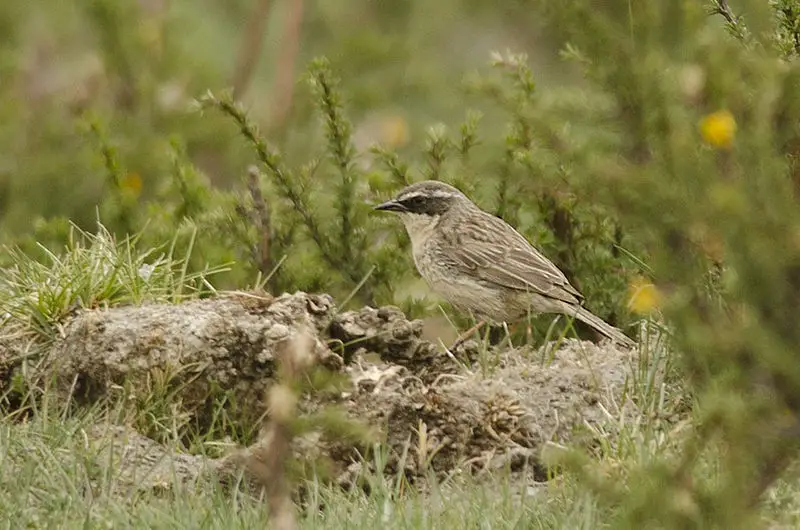
The Brown Accentor is a small bird native to parts of Central Asia and the Middle East. It belongs to the Prunellidae family, which includes some of Europe’s most common passerines.
This species has brown upperparts with lighter spots on its chest and back, while its head and throat are light greyish-white in coloration.
Its underparts are whitish or yellowish-buff that fades into a dark rusty hue at the tail tip.
The Brown Accentor feeds mainly on insects it finds foraging through ground vegetation like low shrubs or grasses but also eats seeds when available.
As such, it prefers dry Mediterranean habitats with sparsely vegetated areas where there is ample food availability throughout the year.
Though relatively widespread across much of their range due to an adaptable nature, this species can be threatened by habitat destruction caused by human activities such as agricultural expansion or urbanizationScientific classification:
| Kingdom | Animalia |
| Phylum | Chordata |
| Class | Aves |
| Order | Passeriformes |
| Family | Prunellidae |
| Genus | Prunella |
| Species | P. fulvescens |
Also Featured In: Birds of Ladakh,
12. Black Francolin
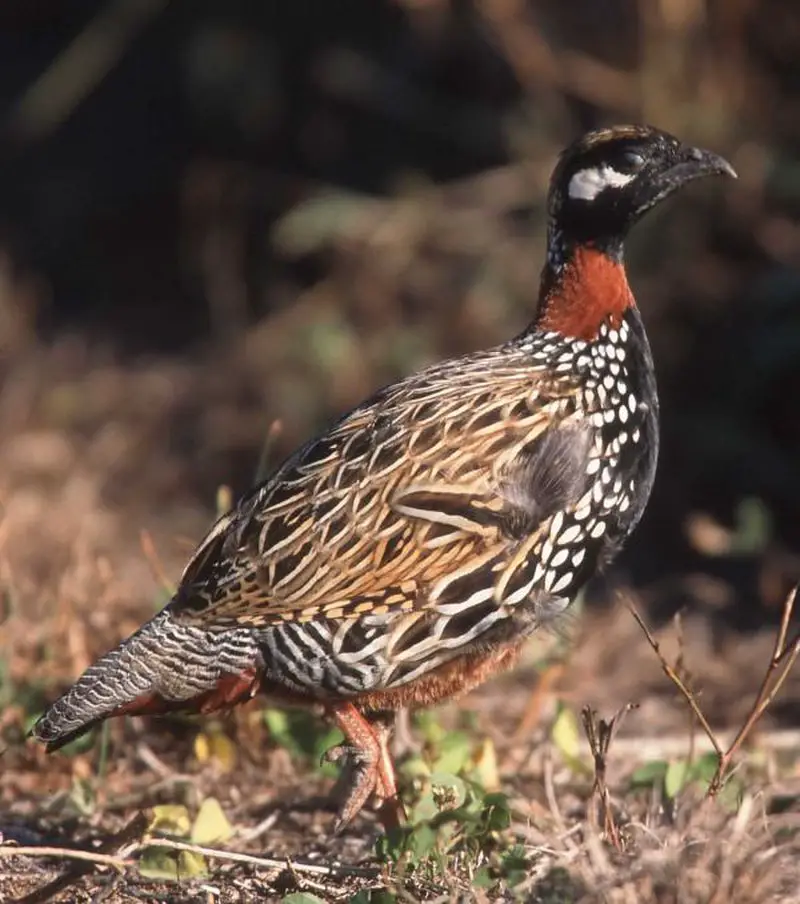
Black francolin is a species of gamebird belonging to the pheasant family. It was once known as black partridge and is now declared as state bird of Haryana, India.
The adult males are generally about 33-36 cm in length with an average weight of 453 gm.
They have glossy black plumage with white spotting on their wings and body parts along with barring patterns on tail feathers which makes them look attractive.
Their call sounds like ‘kattar kattar’ continuously repeated at regular intervals throughout the day during breeding season from April – June when they become highly vocal for mating purpose.
These birds can be found in open grasslands, scrub forests or agricultural fields where plenty of food (mainly insects) is available for survival & reproduction purposes making it one of the most common avifauna across its range countries such as Pakistan, Afghanistan & Nepal etc..Scientific classification:
| Kingdom | Animalia |
| Phylum | Chordata |
| Class | Aves |
| Order | Galliformes |
| Family | Phasianidae |
| Genus | Francolinus |
| Species | F. francolinus |
13. Black-And-Yellow Grosbeak
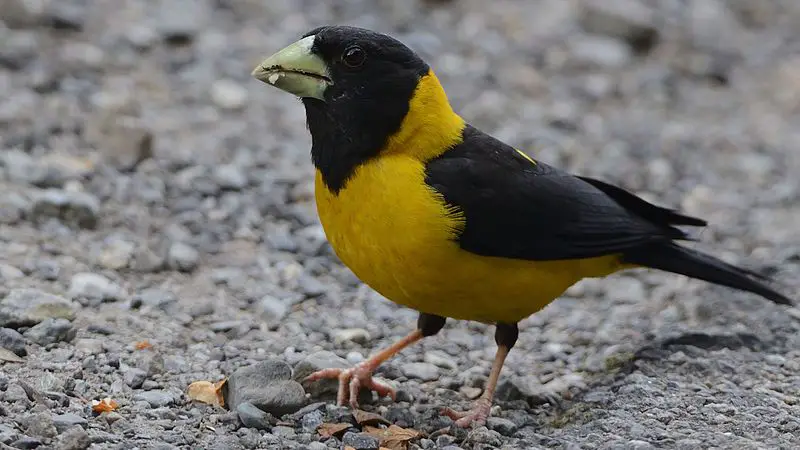
The Black-and-yellow Grosbeak is a species of finch native to northern parts of the Indian subcontinent, primarily in lower and middle Himalayas. It has an unmistakable black head with yellow wings, back and breast which makes it easily identifiable from other birds.
This bird can be found in temperate forests across Afghanistan, India, Iran Nepal and Pakistan. The female grosbeaks have slightly duller colours than males but are still quite striking to look at due to their bright plumage.
They feed on the ground for insects as well as fruits like berries or seeds from trees or shrubs making them omnivores by nature .
All in all ,the Black-andYellow Grosbeak is a beautiful addition to any forest landscape that deserves more recognition for its beauty.Scientific classification:
| Kingdom | Animalia |
| Phylum | Chordata |
| Class | Aves |
| Order | Passeriformes |
| Family | Fringillidae |
| Subfamily | Carduelinae |
| Genus | Mycerobas |
| Species | M. icterioides |
14. Blunt-Winged Warbler
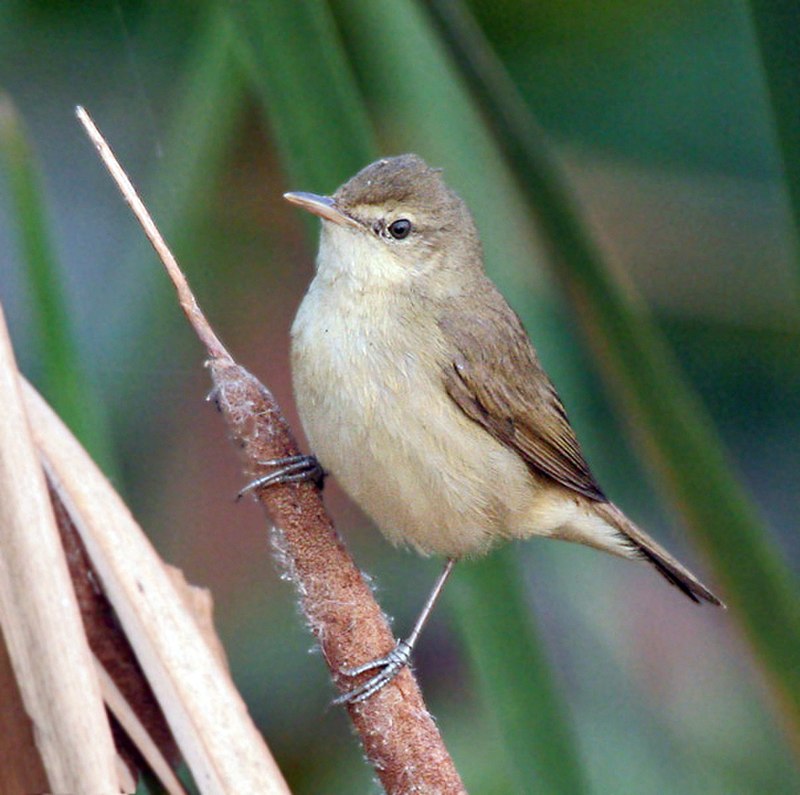
The Blunt-winged Warbler is a marsh-warbler bird species found in several countries of South and Central Asia. It was first described by Robert Swinhoe in 1870, formerly included among the “Old World warblers”.
Its range covers Afghanistan, Pakistan, Northeast India and China while it winters in Myanmar, Thailand and Bangladesh.
This small passerine has olive upperparts with whitish underparts that are heavily streaked dark brown or black on its flanks; its head is greyish with an indistinct pale supercilium above each eye.
The wings have short primary feathers giving them their blunt appearance which gives this species its name; they also feature yellowish fringes to the greater coverts along with white patches on their outer webs near the tips of their tertials.Scientific classification:
| Kingdom | Animalia |
| Phylum | Chordata |
| Class | Aves |
| Order | Passeriformes |
| Family | Acrocephalidae |
| Genus | Acrocephalus |
| Species | A. concinens |
15. Brooks’s Leaf Warbler
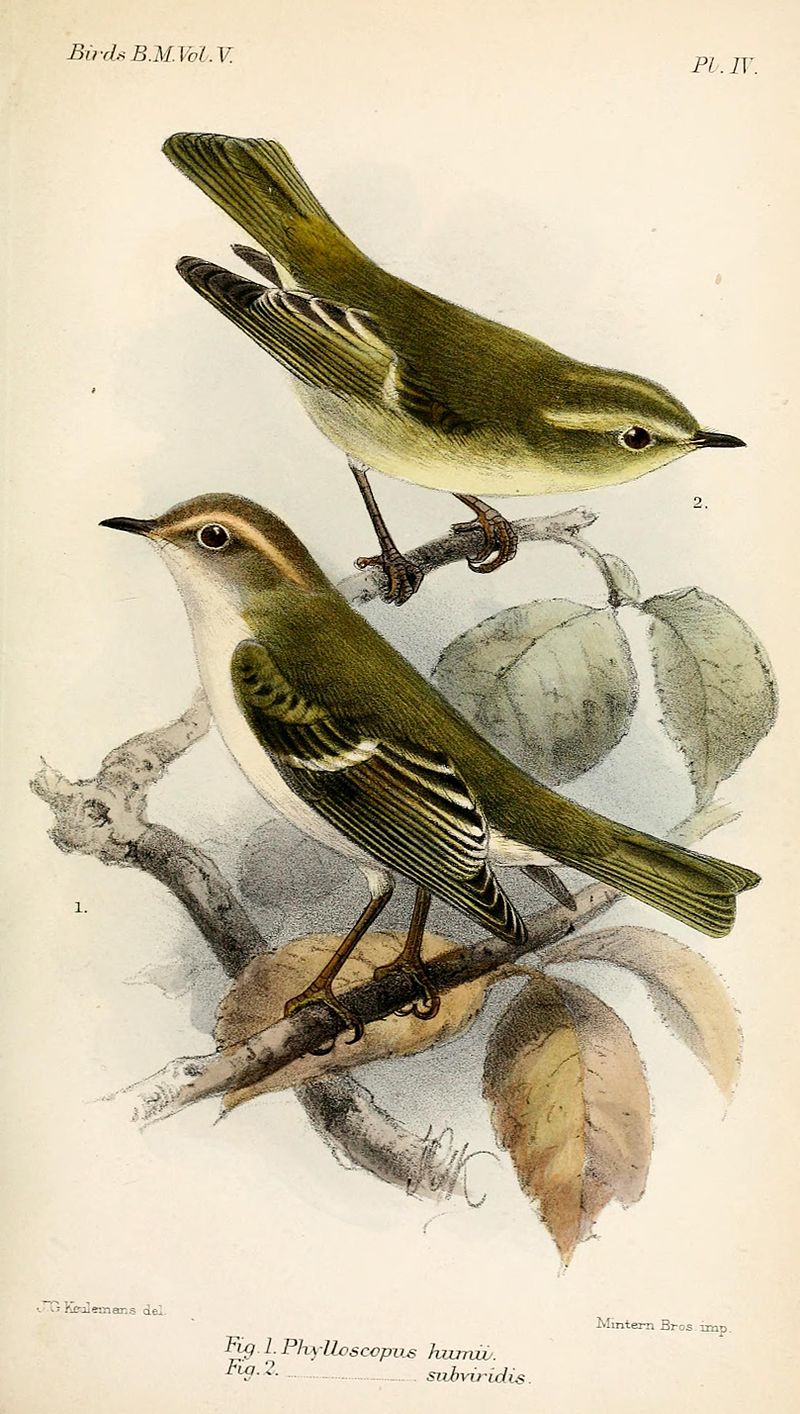
Brooks’s leaf warbler is a species of Old World warbler found in Afghanistan, India, Kazakhstan, Pakistan, Russia and Turkmenistan. It typically inhabits boreal forests and temperate woodlands.
This bird was named after William Edwin Brooks – the father of renowned Canadian bird illustrator Allan Brooks. Its plumage is an overall yellowish-green colour with faint streaks on its back while its underside has white stripes running down it.
The wings are short while the tail feathers are usually longer than most other types of birds within this family. While they can feed themselves upon insects such as moths or beetles they will also consume spiders depending on their availability at any given time or location throughout their rangeScientific classification:
| Kingdom | Animalia |
| Phylum | Chordata |
| Class | Aves |
| Order | Passeriformes |
| Family | Phylloscopidae |
| Genus | Phylloscopus |
| Species | P. subviridis |
16. Bar-Tailed Lark
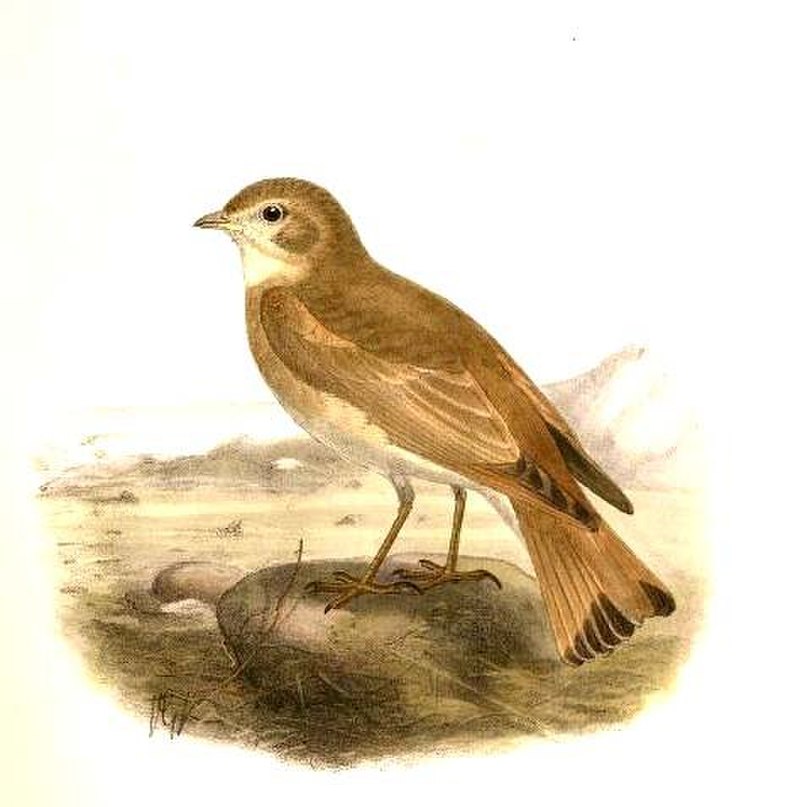
The Bar-tailed Lark is a species of lark belonging to the family Alaudidae. It is found in hot deserts from Morocco all the way to Pakistan, and can be quite common depending on its location.
Its plumage is mostly greyish brown with white patches on its wings and tail feathers. The underside has pale streaks, which vary depending upon subspecies.
They feed mainly on insects and seeds collected near ground level or sometimes plucked directly off plants while perching upright at their tips like other members of this family do when feeding.
During breeding season they form pairs that often defend small territories around their nest sites by singing loud territorial songs – making them easily recognisable birds in otherwise silent desert landscapes.Scientific classification:
| Kingdom | Animalia |
| Phylum | Chordata |
| Class | Aves |
| Order | Passeriformes |
| Family | Alaudidae |
| Genus | Ammomanes |
| Species | A. cinctura |
17. Blue Whistling Thrush
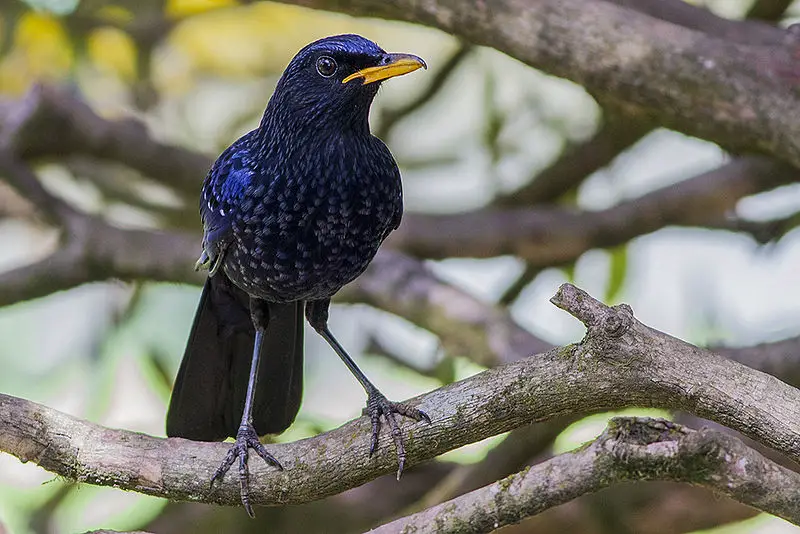
The Blue Whistling Thrush is a species of bird found in the mountains of Central, South and Southeast Asia. It has distinct variations in size and plumage amongst its many subspecies.
The most notable feature about this species is its loud human-like whistling song at dawn and dusk which can be heard over vast distances.
They are ground feeders with their diet consisting mainly of insects supplemented by fruits, seeds, flowers and nectar when available.
These birds also have an affinity for water sources such as streams or pools where they often bathe themselves to keep cool during hot summer days.
With their stunning coloration combined with iconic song it’s no wonder that these birds remain popular among birdwatchers all around the world.Scientific classification:
| Kingdom | Animalia |
| Phylum | Chordata |
| Class | Aves |
| Order | Passeriformes |
| Family | Muscicapidae |
| Genus | Myophonus |
| Species | M. caeruleus |
18. Hume’s Wheatear
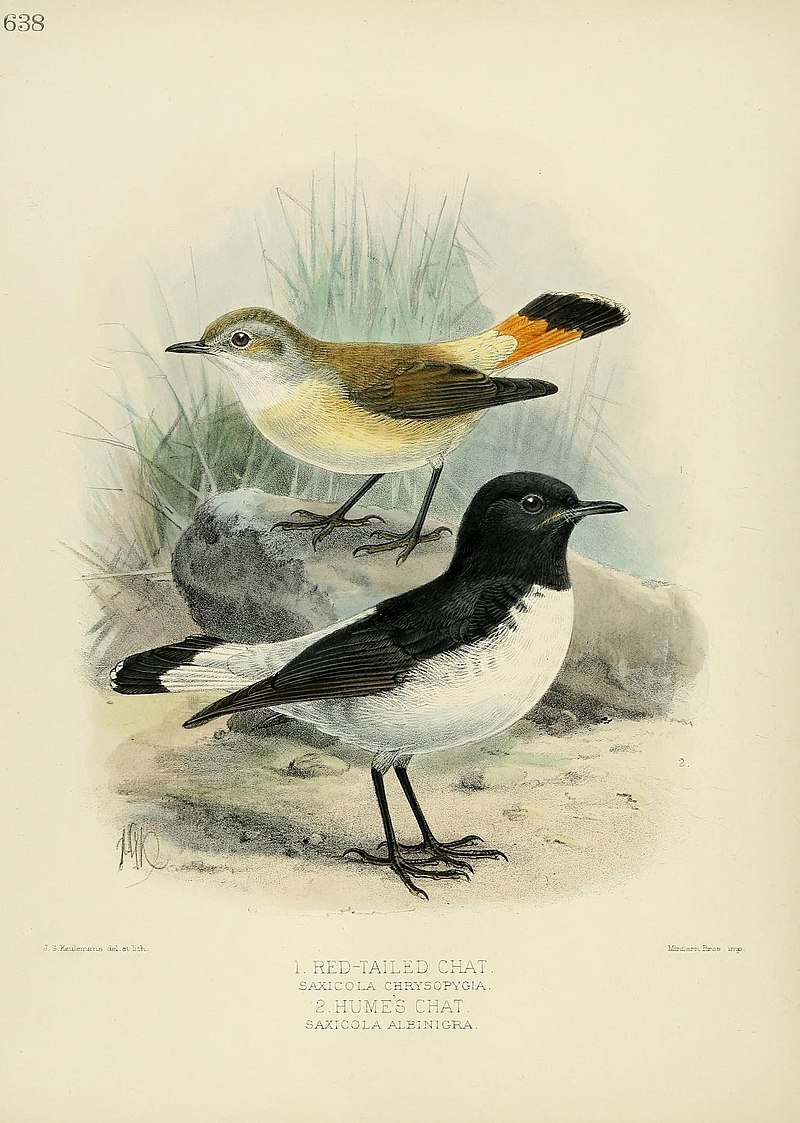
Hume’s wheatear is a species of bird found in the Middle East and parts of Southern Asia. It belongs to the family Muscicapidae, which contains many other small insectivorous birds like flycatchers and chats.
The Hume’s Wheatear has distinctive black-and-white plumage with bold barring on its wings and tail feathers. Its name commemorates British naturalist Allan Octavian Hume who worked extensively in India during his lifetime studying Indian wildlife, including this particular species of songbird.
They are usually found inhabiting open areas such as deserts or grasslands where they can hunt for their insect prey while also remaining hidden from potential predators. Their diet consists mainly of insects but occasionally includes berries too.
All these factors make them an important part of any local ecosystem; so if you’re ever lucky enough to spot one keep your eyes peeled – it might be a rare sighting indeed.Scientific classification:
| Kingdom | Animalia |
| Phylum | Chordata |
| Class | Aves |
| Order | Passeriformes |
| Family | Muscicapidae |
| Genus | Oenanthe |
| Species | O. albonigra |
19. Brown-Fronted Woodpecker
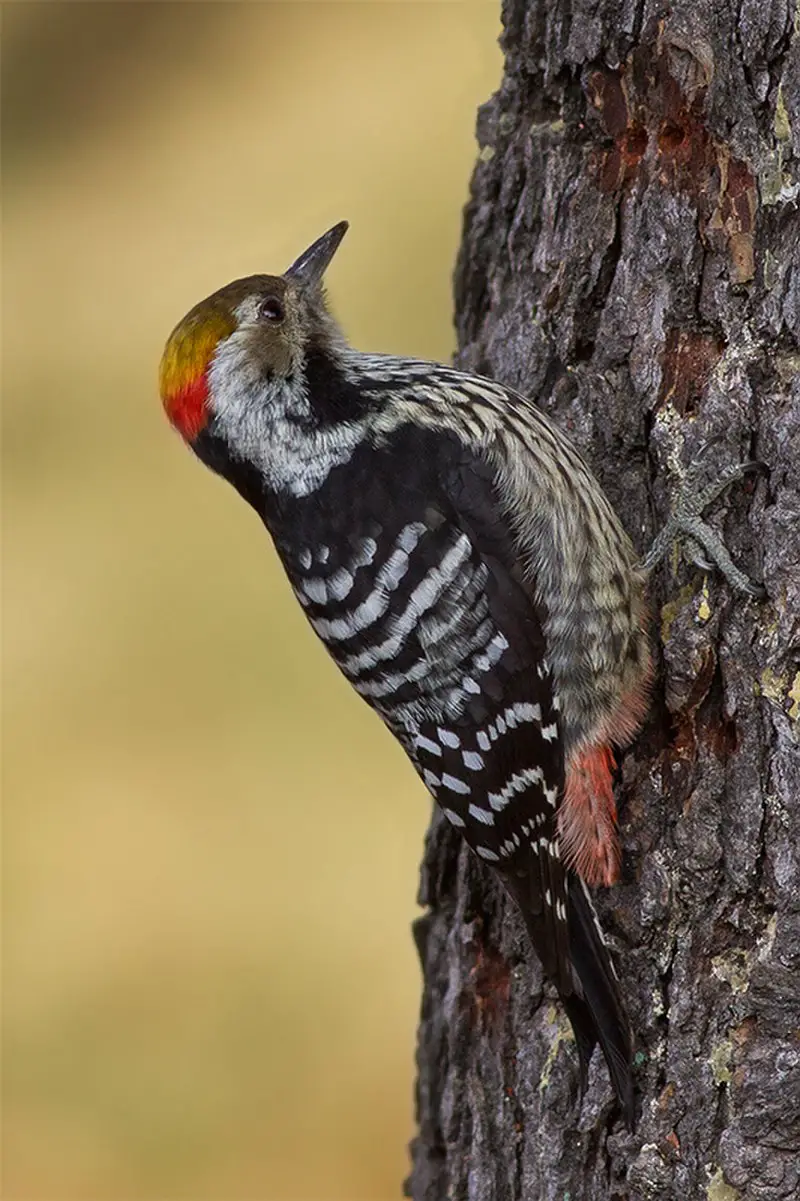
The Brown-fronted Woodpecker is a species of bird that belongs to the Picidae family. It inhabits the northern regions of India, primarily in lower and middle altitudes of Himalayas, as well as Afghanistan, Nepal, Pakistan and Bhutan.
These birds are known for their distinct brown front with white spots on either side near its forehead. They typically feed on ants and other insects which they find by tapping or pecking at tree bark with their strong beaks.
Besides insect prey these woodpeckers also occasionally eat fruits such as berries from nearby trees too.
Taxonomically speaking this species may belong to either Dendrocopos or Leiopicus genera depending upon various authorities; however both agree on one thing – it’s an amazing sight to behold when you spot them flitting around looking for food.Scientific classification:
| Kingdom | Animalia |
| Phylum | Chordata |
| Class | Aves |
| Order | Piciformes |
| Family | Picidae |
| Genus | Dendrocoptes |
| Species | D. auriceps |
20. White-Winged Woodpecker
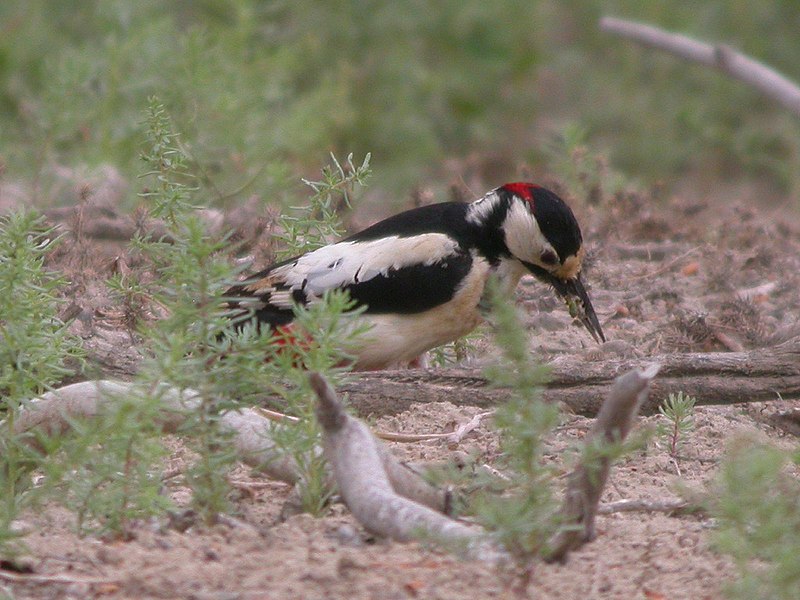
The White-winged woodpecker is a species of bird in the Picidae family. It inhabits temperate and subtropical forests across Afghanistan, China, Iran, Kazakhstan, Kyrgyzstan, Tajikistan., Turkmenistan and Uzbekistan.
This bold yet timid creature has a black body with white wings that are visible when it flies or perches on trees.
Its most distinguishable feature though is its bright red crest atop its head which can be seen from afar making them easily recognizable among other birds in their habitat.
They feed mainly on insects but they also eat nuts and fruits found around tree trunks as well as suet scattered by humans at times; all done with powerful bill equipped to break through tough bark surfaces without effort.
The White-winged Woodpecker may not have any special status under conservation laws but let’s hope we take better care of this beautiful bird so future generations can appreciate its captivating beauty too.Scientific classification:
| Kingdom | Animalia |
| Phylum | Chordata |
| Class | Aves |
| Order | Piciformes |
| Family | Picidae |
| Genus | Dendrocopos |
| Species | D. leucopterus |
21. Afghan Babbler
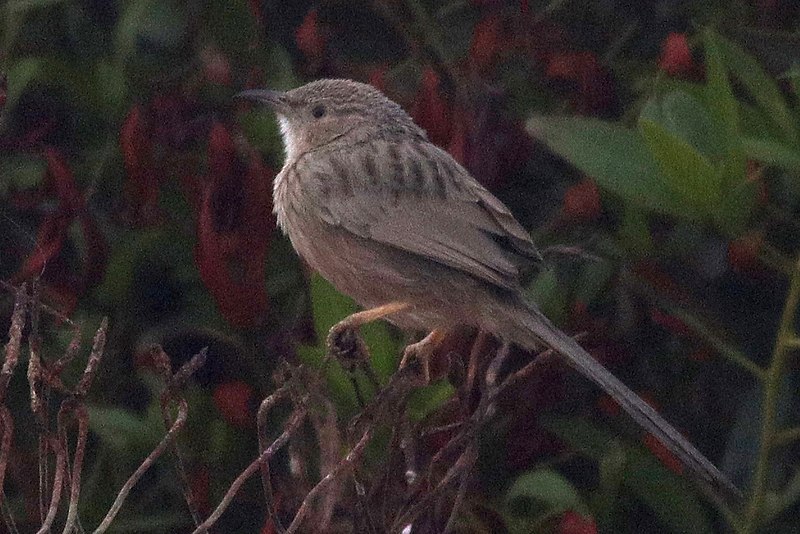
The Afghan babbler is a species of bird found in southeastern Iraq and southwestern Pakistan.
It was formerly classified as a subspecies of the common babbler but can be distinguished by its heavier bill and dark streaks on the breast and sides.
Its vocalizations also differ from those of its counterpart, making it easy to identify.
These birds are often seen foraging together in groups or pairs, searching for food such as insects, fruits, seeds and small vertebrates like lizards or frogs.
They sometimes flock with other species such as mynas or barbets when there is enough food available to share amongst them all.
With their unique features combined with their social behavior they make an interesting addition to any avian enthusiast’s list.Scientific classification:
| Kingdom | Animalia |
| Phylum | Chordata |
| Class | Aves |
| Order | Passeriformes |
| Family | Leiothrichidae |
| Genus | Argya |
| Species | A. huttoni |
22. Himalayan Snowcock
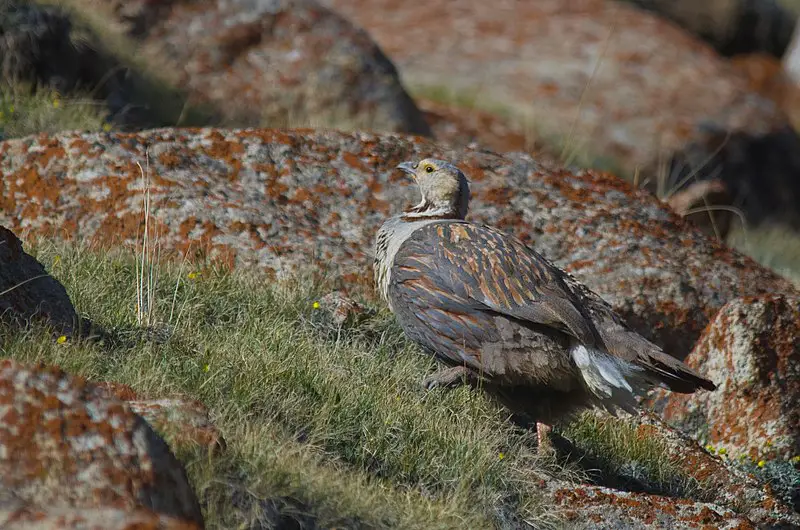
The Himalayan snowcock is a beautiful bird native to the remote, alpine regions of the Himalayas and Pamir range. They prefer rocky cliffs where they can dive into steep hill slopes for safety.
These birds are large in size compared to their closely related species, the Tibetan snowcock, with males reaching up to 25 inches long and weighing an average 2 pounds.
The plumage on these birds varies from grey-brown wings with white spotting along its backside and black barring on tail feathers; while underbelly feathers are bright rusty orange coloration.
Its diet consists primarily of plant matter such as seeds, grasses and flower buds found amongst rocks or high mountain meadows during summer months when it migrates higher up in altitude seeking cooler temperatures during hot season.Scientific classification:
| Kingdom | Animalia |
| Phylum | Chordata |
| Class | Aves |
| Order | Galliformes |
| Family | Phasianidae |
| Genus | Tetraogallus |
| Species | T. himalayensis |
23. Scaly-Bellied Woodpecker
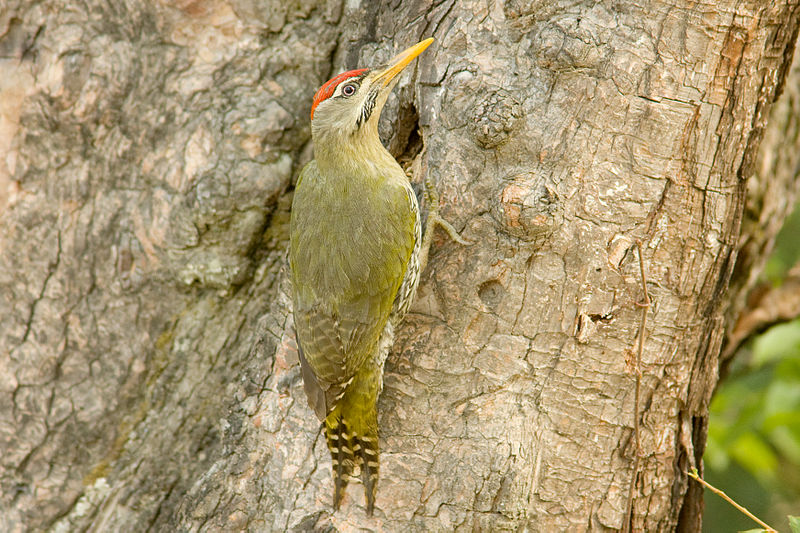
The Scaly-bellied Woodpecker is a large, green bird with distinct scaling on its breast. It inhabits boreal forests, temperate forests and subtropical or tropical moist lowland forest across Afghanistan, Iran, India , Nepal , Pakistan and Turkmenistan .
This species of the Picidae family feeds mainly on small insects like ants that it finds in tree bark by pecking at them.
The woodpecker also eats fruits and nuts depending upon availability in its habitat. Its call sound resembles to ‘kik’ which can be heard during early morning hours when they are looking for food.
Being an arboreal bird it prefers staying close to tall thick trees as protection from predators while hunting or resting between flights.Scientific classification:
| Kingdom | Animalia |
| Phylum | Chordata |
| Class | Aves |
| Order | Piciformes |
| Family | Picidae |
| Genus | Picus |
| Species | P. squamatus |
24. Large-Billed Reed Warbler
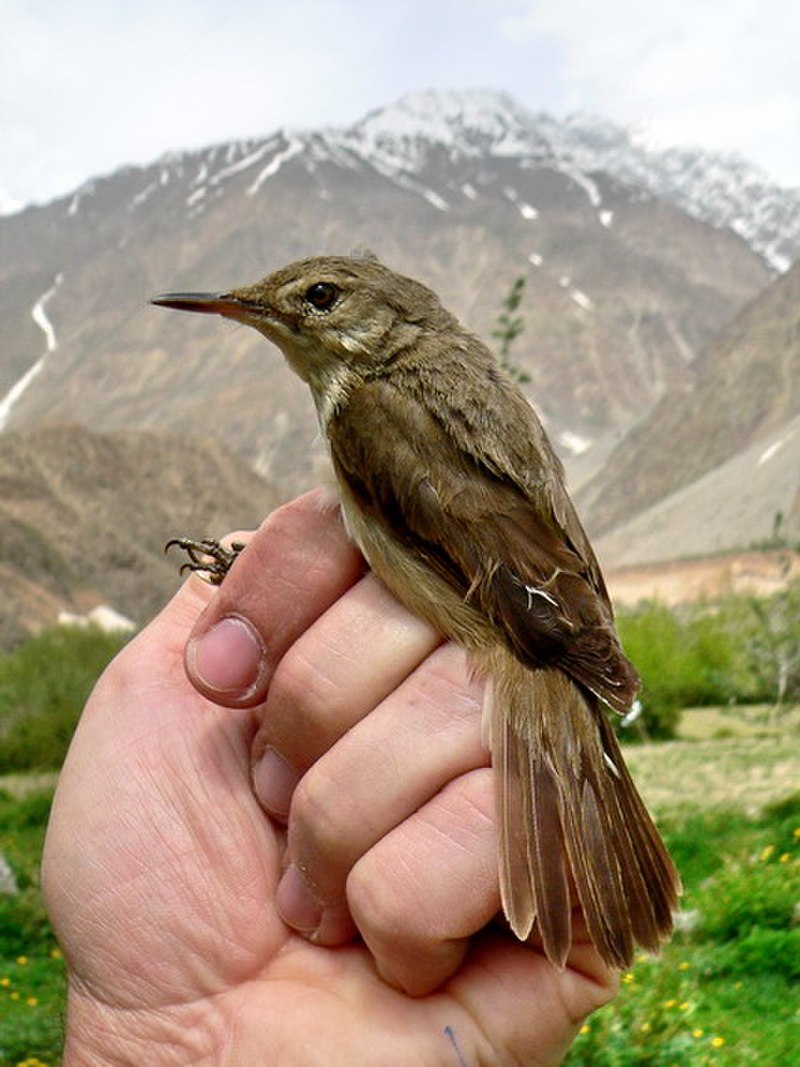
The Large-billed Reed Warbler is a mysterious bird that has been dubbed “the world’s least known”. It was first discovered in India 1867 and then rediscovered in Thailand 2006 through DNA matching.
This small warbler measures between 13 to 15 cm long, with a large bill and has brown plumage on its upperparts while the underparts are whitish.
They primarily inhabit wetlands such as marshes, river banks or reed beds where they feed mainly on insects found among aquatic vegetation.
The species is threatened due to habitat destruction caused by human activities like draining of wetland areas for development projects or farming expansion.
Conservation efforts must be implemented so this unique species can survive into future generations.Scientific classification:
| Kingdom | Animalia |
| Phylum | Chordata |
| Class | Aves |
| Order | Passeriformes |
| Family | Acrocephalidae |
| Genus | Acrocephalus |
| Species | A. orinus |
25. Black-Crested Tit
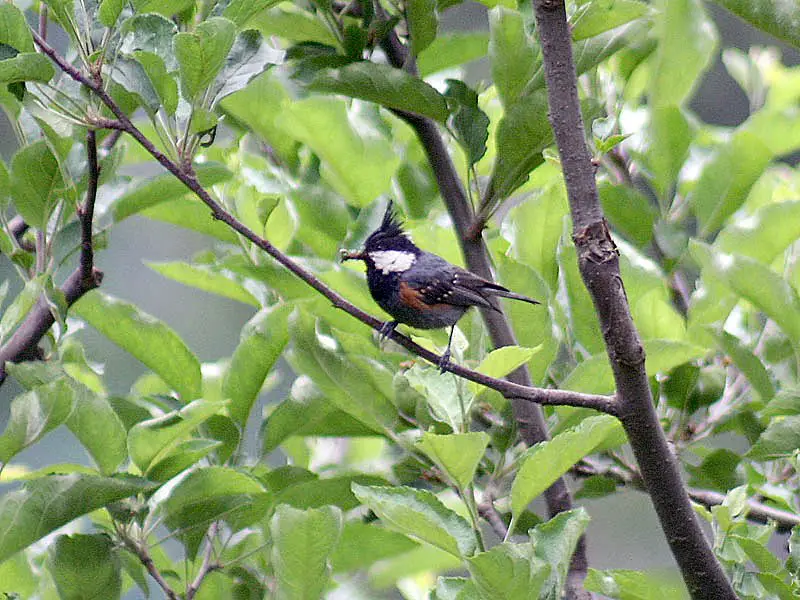
The Black-crested Tit, also known as the Spot-winged Tit, is a beautiful bird of the Paridae family. It has a black cap and wings with white spots on them.
This species was once considered its own species but now it is mostly classified as a subspecies of Coal tit. The range of this bird stretches across Afghanistan, Bhutan, India , Nepal and Pakistan in Northern parts of Indian Subcontinent within boreal forests and temperate forests present in Himalayas region .
These birds feed mainly on small insects like ants and other invertebrates along with some seeds here & there. They are generally seen in flocks around their nesting area which they use to look out for predators or food sources nearby.
All these features together make up this unique yet graceful creature that we call the Black-Crested Tit.Scientific classification:
| Kingdom | Animalia |
| Phylum | Chordata |
| Class | Aves |
| Order | Passeriformes |
| Family | Paridae |
| Genus | Periparus |
| Species | P. ater |
| Subspecies | P. a. melanolophus |
26. Red-Fronted Rosefinch
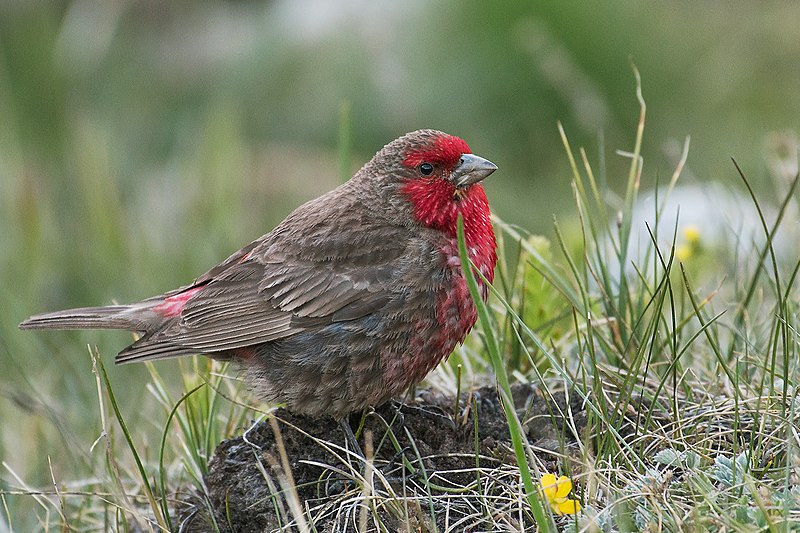
The Red-fronted Rosefinch is a species of rosefinch in the finch family Fringillidae. It has an impressive range, spanning across Afghanistan, Bhutan, China, India, Kazakhstan Nepal Pakistan Russia Tajikistan and Turkmenistan.
These birds can be found inhabiting montane tundra areas. Their feathers are mainly red with grey wings and tail plumage – males usually have brighter colors than females.
They feed on seeds as well as insects such as beetles or flies caught from foliage or ground surfaces during foraging flights.
These birds nest near rocks where they build cup shaped nests among shrubs at low altitudes but will also sometimes settle higher up into trees when conditions permit it.Scientific classification:
| Kingdom | Animalia |
| Phylum | Chordata |
| Class | Aves |
| Order | Passeriformes |
| Family | Fringillidae |
| Subfamily | Carduelinae |
| Genus | Carpodacus |
| Species | C. puniceus |
27. Red-Mantled Rosefinch
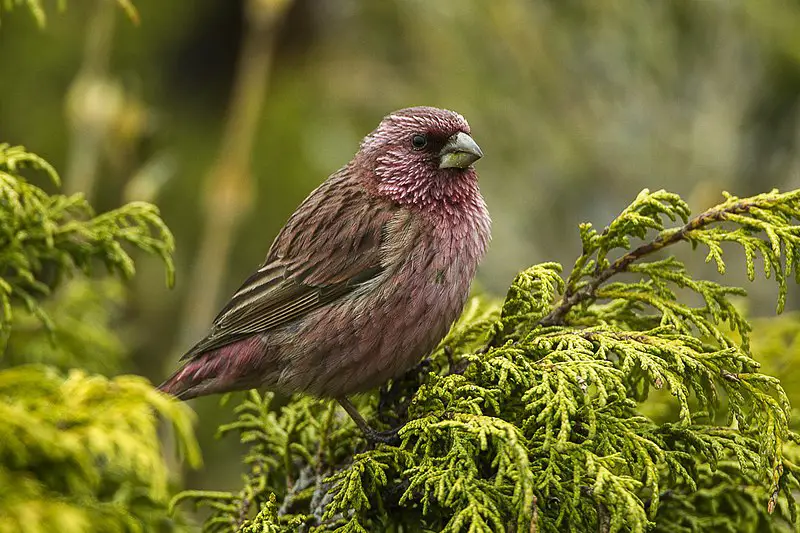
The Red-mantled Rosefinch is a species of finch that can be found in countries such as Afghanistan, China, India, Iran and Tajikistan. It inhabits temperate forests and boreal shrublands where it feeds on seeds from plants like grasses or small fruits.
This bird has greyish brown feathers with red patches on the shoulders which gives its name. The underside is white while the tail is black tipped with yellow or white.
Its wings are short but they help them to fly fast when needed for defence against predators or searching food sources during migrations; some individuals may even travel up to 1000 km.
In summertime this bird forms pairs to nest in trees near water bodies or meadows making their nests using moss, lichens and feathers lined up inside for warmth and protection of eggs until chicks hatch out after 12 days incubation period by both parents taking turns sitting on themScientific classification:
| Kingdom | Animalia |
| Phylum | Chordata |
| Class | Aves |
| Order | Passeriformes |
| Family | Fringillidae |
| Subfamily | Carduelinae |
| Genus | Carpodacus |
| Species | C. rhodochlamys |